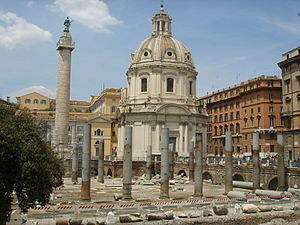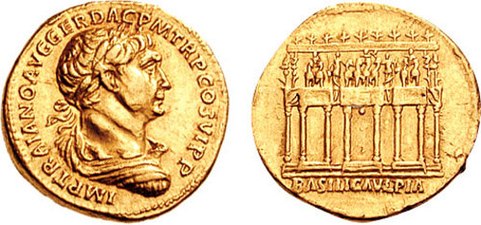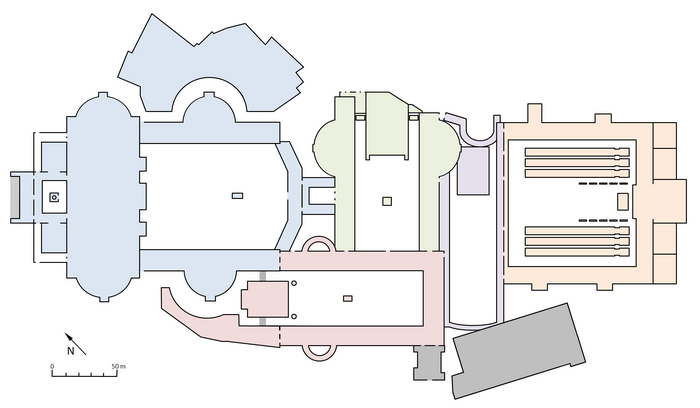Basilica Ulpia
| Basilica Ulpia | |
| Basilika | |
Avbrutna kolonner vid Basilica Ulpia. Till vänster Trajanuskolonnen och i bakgrunden kyrkan Santissimo Nome di Maria. | |
| Land | |
|---|---|
| Region | Lazio |
| Ort | Rom |
| Adress | Trajanus forum dagens Piazza Foro Traiano |
| Koordinater | 41°53′44″N 12°29′04.46″Ö / 41.89556°N 12.4845722°Ö |
| Byggherre | Trajanus |
| Färdigställande | 112 e.Kr. |
| Lägeskarta | |
Plan över Basilica Ulpia. | |
Basilica Ulpia var en basilika i antikens Rom. Den var uppkallad efter kejsar Trajanus, vars fullständiga namn var Marcus Ulpius Traianus, och invigdes i januari år 112 e.Kr. Basilikan, som mätte 170 x 60 meter, var den dittills största som hade byggts i Rom.[1]
Basilica Ulpia tog över mycket av de äldre basilikornas – Basilica Aemilias och Basilica Iulias – funktion och Roms politiska liv och rättsförhandlingar flyttade från Forum Romanum till Trajanus forum. Basilikan hade ett mittskepp och fyra sidoskepp, två på vardera sida. Kortsidorna hade absider. Basilikans 96 kolonner var i grön marmor från Carystus eller granit och dess tak var belagt med förgylld brons.[2][3] På fasadens fris stod namnen på de segerrika legioner som hade stridit i Trajanus fälttåg i Dacien, bland andra XI Claudia, XV Apollinaris och XX Valeria Victrix.[4]
Utgrävningar
Mellan 1809 och 1814 utgjorde Rom ett departement inom Första franska kejsardömet under Napoleon. De franska myndigheterna beslutade att gräva ut Basilica Ulpia. De två kyrkorna – Santo Spirito och Sant'Eufemia – som hade byggts på denna plats revs år 1812 och året därpå inleddes utgrävningarna.[5]
Efter Napoleons fall år 1814 återkom påve Pius VII till Rom och lät fortsätta utgrävningarna.[6]
Bilder
|
Källor
Noter
- ^ Coarelli 1980, s. 113
- ^ Pausanias, Descriptio Græciæ, V:12:6
- ^ Platner 1929, s. 241
- ^ Lanciani 1897, s. 315–316
- ^ Lanciani 1897, s. 314–315
- ^ Lanciani 1897, s. 315
Tryckta källor
- Claridge, Amanda (1998) (på engelska). Rome: An Oxford Archaeological Guide. Oxford Archaeological Guides, 99-2662277-1. Oxford: Oxford University Press. sid. 162–164. ISBN 0-19-288003-9
- Coarelli, Filippo (1980) (på italienska). Guida archeologica di Roma (3). Milano: Arnoldo Mondadori. sid. 113–116. OCLC 7187657
- Lanciani, Rodolfo (1897) (på engelska). The Ruins and Excavations of Ancient Rome. Boston: Houghton, Mifflin and Company. sid. 314–316. https://archive.org/details/ruinsexcavations00lanc/page/314/mode/2up/search/legions
- Platner, Samuel Ball (1911) (på engelska). The Topography and Monuments of Ancient Rome. Boston: Allyn and Bacon. sid. 287. https://archive.org/details/topographymonume00platiala/page/286/mode/2up
- Platner, Samuel Ball (1929) (på engelska). A Topographical Dictionary of Ancient Rome. London: Oxford University Press. sid. 241–242. https://penelope.uchicago.edu/Thayer/E/Gazetteer/Places/Europe/Italy/Lazio/Roma/Rome/_Texts/PLATOP*/Forum_Trajani.html#basilica_Ulpia
- Richardson, Lawrence (1992) (på engelska). A New Topographical Dictionary of Ancient Rome. Baltimore, Maryland: Johns Hopkins University Press. sid. 89. ISBN 0-8018-4300-6
Externa länkar
 Wikimedia Commons har media som rör Basilica Ulpia.
Wikimedia Commons har media som rör Basilica Ulpia.
| Fora Imperatorum i Rom |
|---|
Porticus Curva Senatens sekretariat Forma Urbis Severiana Tempel vid Via Sacra Bibliotek Drusus triumfbåge Germanicus triumfbåge Quadriga Fredstemplet Ryttarstaty |
Media som används på denna webbplats
Författare/Upphovsman: Cassius Ahenobarbus, Licens: CC BY-SA 3.0
Vestiges de la partie nord du forum de Trajan avec à gauche les ruines de la basilique Ulpia et complètement à droite le piédestal de la colonne Trajanne. En arrière-plan, le monument à Victor-Emmanuel II.
Författare/Upphovsman: Cassius Ahenobarbus, Licens: CC BY-SA 3.0
Plan des Forums impériaux.
(c) Classical Numismatic Group, Inc. http://www.cngcoins.com, CC BY-SA 2.5
TRAJAN. 98-117 AD.
- AV Aureus (7.24 gm, 8h). Struck 112 AD.
- IMP TRAIANO AVG GER DAC P M TR P COS VI P P, laureate, draped, and cuirassed bust right, seen from behind;
- BASILICA VLPIA in exergue, the Basilica Ulpia: building façade with three distyle avant-corps, each set on two-tiered base; central epistylon surmounted by triumphal quadriga; figures on either side holding outer horses and long sceptres; flanking epistyla each surmonted by biga; pair of legionary aquilae at outer ends; ornate architrave above.
- RIC II 247; Strack 202b; BMCRE 492; Calicó 988; cf. Cohen 42-43.
Författare/Upphovsman: Sailko, Licens: CC BY 2.5
Foro, Traiano area, in Rome, Italy
Författare/Upphovsman: Internet Archive Book Images, Licens: No restrictions
Identifier: ramblesinromearc00forb (find matches)
Title: Rambles in Rome : an archæological and historical guide to the museums, galleries, villas, churches, and antiquities of Rome and the Campagna
Year: 1887 (1880s)
Authors: Forbes, S. Russell
Subjects: Art -- Rome Rome -- Guidebooks Rome -- Antiquities
Publisher: London www.flickr.com/photos/internetarchivebookimages/tags/book...
Contributing Library: University of California Libraries
Digitizing Sponsor: MSN
View Book Page: Book Viewer
About This Book: Catalog Entry
View All Images: All Images From Book
Click here to view book online to see this illustration in context in a browseable online version of this book.
Text Appearing Before Image:
as-reliefs, representing the Dacian war, forms a spiral round the shaftof the pillar. Erected a.d. 114. It is 127 feet high, including thebase, and is surmounted by a statue of S. Peter, 11 feet high, jjlacedthere by Sixtus V. in the sixteenth century. The pillar is composed of thirty-four blocks of white marble. Thereliefs are two feet high at the bottom, and gradually increase insize as they go upwards, thus making the figures at the top andbottom seem of equal size. There are two thousand five hundredfigures, besides animals and other details. Dion Cassius (Xiphilin, Trajan) says : He erected in the forumthat bears his name a vast pillar, as well to serve as a receptacle forhis bones as to be a monument of his magnificence to posterity.In good earnest, it was a piece of work that could not be finishedwithout extraordinary expense, because it was necessary to cut PLAN OF THE FORUM OF TRAJAN TEMPLEofTRAJAN 1 ; JJ ;j?j • > JJ-i , COLUMN I ItiAjtjTT :JtlBR»ByJ \ ■p r LlBRARYi^:
Text Appearing After Image:
220 llA.MliLK IV. through a mouutaiu as high as the piUai, to make the level for theforum. The bones of Trajan were put into the pillar we have mentioned;and, to reverence his memory, sports were celebrated for severalyears after, which were called Parthica (Dion Cassius, Hadrian). Trajan, of all the emperors, was buried within the city. Hisbones, being put up in a golden urn, lie in the forum which he built,imder a pillar, whose height is 144 feet, Roman (Eutropius). Going down the Via Alessandrina, ^ohich commences at the left-hand corner of the above forum, as toe come into it, take the first turningon the left, Via Campo Carleo. The .gate on the left leads to thedoable row of shops that surrounded the Forum of Trajan. Custodiat the Forum. Following this street, we pass the medieval Torre del Grilleon our left. On our right are massive remains of the Second WallOF Rome. (See page xviii.) Turning to the right under the arch, we are within THE FORUM OF AUGUSTUS. The reason of his bui
Note About Images










